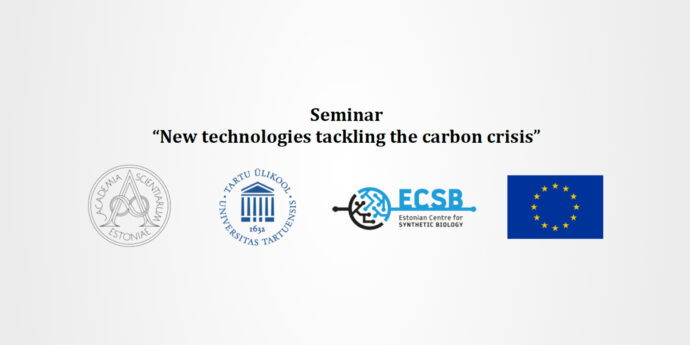On December 3rd 2019, GasFermTEC, Estonian Centre for Synthetic Biology, and the Estonian Academy of Sciences organised the seminar „New technologies tackling the carbon crisis“ that introduced new technologies and focused on gas fermentation as one of the key technology with significant potential towards combating the global carbon crisis through enabling the sustainable production of fuels and chemicals from waste feedstock (e.g. industrial waste gases, biomass, municipal solid waste, direct air captured CO2). The seminar included presentations from technology experts, scientists and policy makers.
One of the keynote speakers Carl Wolf (Vice-President Europe) of the leading US biotechnology company LanzaTech concentrated mainly on the application of LanzaTech’s industrial-scale gas fermentation technologies for recycling carbon from industrial waste gases (CO, CO2) and from syngas (CO, CO2, and H2) derived from gasification of municipal solid waste (MSW) and lignocellulosic biomass. Aspects of solid waste gasification were thoroughly covered by Pekka Simell (Principal Scientist) from the VTT Bioruukki Pilot Plant, a leading gasification research centre in Finland. Presentations specifically highlighted that gas fermentation enables to recycle carbon from very different waste streams, that the technology does not compete with food production regarding its feedstock, and that it enables to nearly fully utilise all the carbon in lignocellulosic biomass (including lignin).
Gas fermentation activities in Estonia were presented by Kaspar Valgepea, group leader at the ERA Chair GasFermTEC, who has lead the development of a dedicated state-of-the-art gas fermentation laboratory at the University of Tartu. In addition to novel electrolysis, synthetic photosynthesis, and direct air capture of CO2 technologies, also metabolism of acetogenic bacteria were introduced who are the biocatalysts enabling to recycle waste carbon and energy. One of the aims of GasFermTEC is to achieve a better understanding of acetogen metabolism for subsequent rational engineering of superior cell factories in collaboration with LanzaTech.
In addition to the aforementioned speakers, the seminar included an opening address by Tarmo Soomere (President of the Estonian Academy of Sciences) and presentations from Kristjan Vassil (Vice-Rector of Research at University of Tartu), Mart Loog (Professor at University of Tartu and coordinator of GasFermTEC), Mihkel Krusberg (Advisor at Ministry of Environment of Estonia), and Will Wright (Director of Entrepreneurship at the iGEM Foundation).
One focus of the seminar was the introduction of the potential of industrial application of gas fermentation technologies in Estonia. Here, GasFermTEC aims to work in cooperation with different governmental bodies, companies, and EU bio-economy funds towards demonstration and industrial-scale plants for providing solutions for major challenges in recycling waste feedstocks.
Video recordings of presentations
President of the Estonian Academy of Sciences
Estonian Centre for Synthetic Biology, University of Tartu, Estonia
Vice-Rector for Research, University of Tartu.
“Strategies for scaling lab-scale technologies from University of Tartu towards solving major challenges outlined in Estonia 2035”
Vice President of Europe; LanzaTech, USA
“Innovative fuels and chemicals production from waste”
Adviser; Ministry of the Environment of Estonia.
“Trends in the circular economy and waste management for the next decades”
Principal Scientist; VTT Bioruukki Pilot Centre, Finland.
“Carbon recycling via gasification”
Group Leader; ERA Chair in Gas Fermentation Technologies, University of Tartu.
“Gas fermentation in Estonia”
Director of Entrepreneurship; The iGEM foundation.
“Towards an Estonian and Pan-European bio-economy roadmap”
